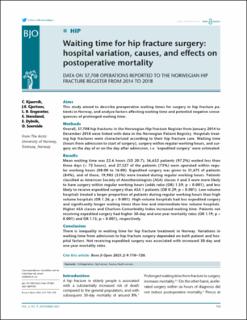| dc.contributor.author | Kjærvik, Cato | |
| dc.contributor.author | Gjertsen, Jan-Erik | |
| dc.contributor.author | Engesæter, Lars B. | |
| dc.contributor.author | Stensland, Eva | |
| dc.contributor.author | Dybvik, Eva Hansen | |
| dc.contributor.author | Søreide, Odd | |
| dc.date.accessioned | 2021-09-07T12:14:05Z | |
| dc.date.available | 2021-09-07T12:14:05Z | |
| dc.date.created | 2021-09-03T19:39:42Z | |
| dc.date.issued | 2021 | |
| dc.identifier.issn | 2633-1462 | |
| dc.identifier.uri | https://hdl.handle.net/11250/2774026 | |
| dc.description.abstract | Aims: This study aimed to describe preoperative waiting times for surgery in hip fracture patients in Norway, and analyze factors affecting waiting time and potential negative consequences of prolonged waiting time.
Methods: Overall, 37,708 hip fractures in the Norwegian Hip Fracture Register from January 2014 to December 2018 were linked with data in the Norwegian Patient Registry. Hospitals treating hip fractures were characterized according to their hip fracture care. Waiting time (hours from admission to start of surgery), surgery within regular working hours, and surgery on the day of or on the day after admission, i.e. ‘expedited surgery’ were estimated.
Results: Mean waiting time was 22.6 hours (SD 20.7); 36,652 patients (97.2%) waited less than three days (< 72 hours), and 27,527 of the patients (73%) were operated within regular working hours (08:00 to 16:00). Expedited surgery was given to 31,675 of patients (84%), and of these, 19,985 (53%) were treated during regular working hours. Patients classified as American Society of Anesthesiologists (ASA) classes 4 and 5 were more likely to have surgery within regular working hours (odds ratio (OR) 1.59; p < 0.001), and less likely to receive expedited surgery than ASA 1 patients (OR 0.29; p < 0.001). Low-volume hospitals treated a larger proportion of patients during regular working hours than high volume hospitals (OR 1.26; p < 0.001). High-volume hospitals had less expedited surgery and significantly longer waiting times than low and intermediate-low volume hospitals. Higher ASA classes and Charlson Comorbidity Index increased waiting time. Patients not receiving expedited surgery had higher 30-day and one-year mortality rates (OR 1.19; p < 0.001) and OR 1.13; p < 0.001), respectively.
Conclusion: There is inequality in waiting time for hip fracture treatment in Norway. Variations in waiting time from admission to hip fracture surgery depended on both patient and hospital factors. Not receiving expedited surgery was associated with increased 30-day and one-year mortality rates. | en_US |
| dc.language.iso | eng | en_US |
| dc.publisher | British Editorial Society of Bone and Joint Surgery | en_US |
| dc.rights | Attribution-NonCommercial-NoDerivatives 4.0 Internasjonal | * |
| dc.rights.uri | http://creativecommons.org/licenses/by-nc-nd/4.0/deed.no | * |
| dc.title | Waiting time for hip fracture surgery: hospital variation, causes, and effects on postoperative mortality. Data on 37,708 operations reported to the Norwegian Hip fracture Register from 2014 to 2018 | en_US |
| dc.type | Journal article | en_US |
| dc.description.version | publishedVersion | en_US |
| dc.rights.holder | Copyright 2021 the authors | en_US |
| cristin.ispublished | true | |
| cristin.fulltext | postprint | |
| cristin.qualitycode | 1 | |
| dc.identifier.doi | 10.1302/2633-1462.29.BJO-2021-0079.R1 | |
| dc.identifier.cristin | 1931315 | |
| dc.source.journal | Bone & Joint Open (BJO) | en_US |
| dc.source.pagenumber | 710-720 | en_US |
| dc.identifier.citation | Bone & Joint Open (BJO). 2021, 2 (9), 710-720. | |
| dc.source.volume | 2 | en_US |
| dc.source.issue | 9 | en_US |

